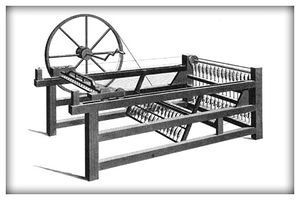Topic 5.5 Technology of the Industrial Age
Jump to navigation
Jump to search
The first factories emerged near rivers and streams for water power, but with the discovery of the energy stored in fossil fuels such as coal and oil, location on rivers was not as important. Coal transformed power by allowing for steam engines. During the Second Industrial revolution gas engines and electricity emerged.
The earliest transformation of the Industrial Revolution was Britain's textile industry. In 1750 Britain already exported wool, linen, and cotton cloth, and the profits of cloth merchants were boosted by speeding up the process by which spinners and weavers made cloth. One invention led to another since none were useful if any part of the process was slower than the others. Some key inventions were:
- The flying shuttle - John Kay's invention carried threads of yarn back and forth when the weaver pulled a handle, greatly increasing the weavers' productivity.
- The spinning jenny - James Hargreaves' invention allowed one spinner to work eight threads at a time, increasing the output of spinners, allowing them to keep up with the weavers. Hargreaves named the machine for his daughter.
- The water frame - Richard Arkwright's invention replaced the hand-driven spinning jenny with one powered by water power, increasing spinning productivity even more.
- The spinning mule - In 1779, Samuel Crompton combined features of the spinning jenny and the water frame to produce the spinning mule. It made thread that was stronger, finer, and more consistent than that made by earlier machines. He followed this invention with the power loom that sped up the weaving process to match the new spinners.

